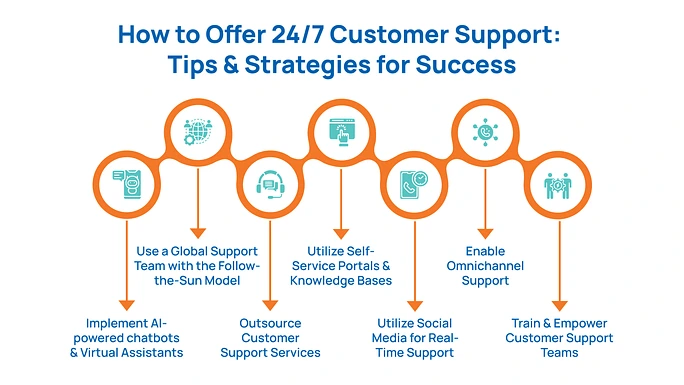- How do you meet customer demands without burning out your team?
- How do you balance cost-efficiency with high-quality service?
- How do you ensure support across different time zones and channels?
Key Takeaways
|
Why is 24/7 Customer Support Essential?
Customer expectations have changed dramatically. 90% of customers consider an immediate response essential when they have a support request. 79% of consumers expect brands to provide 24/7 support options through digital channels like live chat, social media, and AI-powered chatbots. Here is why 24/7 customer support is essential for your business:-
Enhances Customer Satisfaction and Loyalty
-
Reduces Customer Churn
-
Expands Your Global Reach
-
Gives You a Competitive Advantage
How to Offer 24/7 Customer Support: Tips & Strategies for Success
 Here are the best methods for implementing 24/7 customer support to benefit your business and customers.
Here are the best methods for implementing 24/7 customer support to benefit your business and customers.
-
Implement AI-powered chatbots & Virtual Assistants
-
Use a Global Support Team with the Follow-the-Sun Model
-
Outsource Customer Support Services
- Choose a provider with expertise in your industry – A telecom BPO will handle your industry’s technical queries better than a general provider.
- Ensure brand consistency – Provide training materials and SOPs to align the outsourced team with your brand.
- Monitor quality control – Use call monitoring, feedback systems, and regular performance reviews to maintain service quality.
-
Utilize Self-Service Portals & Knowledge Bases
-
Utilize Social Media for Real-Time Support
-
Enable Omnichannel Support
- Live chat & AI chatbots for immediate responses.
- Phone & email support for detailed inquiries.
- Social media & SMS for real-time updates.
- Self-service portals for quick troubleshooting.
-
Train & Empower Customer Support Teams
Best Practices to Keep Customers Happy with 24/7 Support
Here’s how to ensure your 24/7 support keeps customers happy and strengthens brand loyalty.-
Focus on Fast & Efficient Response Times
- Automated Ticket Routing: Ensure customer queries go directly to the right department or agent. AI can categorize tickets based on urgency, complexity, and customer history.
- AI-Assisted Responses: AI chatbots can handle FAQs instantly, providing immediate solutions for common issues. For more complex cases, AI can gather customer details before routing them to a live agent, reducing response time.
- Clear Escalation Protocols: Define when and how issues should be escalated from chatbots to human agents. Ensure your team knows which cases require urgent attention (e.g., payment issues, account lockouts).
-
Create Personalized Experiences
-
Provide Proactive Customer Support
-
Collecting and Acting on Customer Feedback
Master 24/7 Support with Cutting-Edge CCaaS Solutions
Why CCaaS is Essential for 24/7 Customer Support
Customers reach out through different phone, email, chat, social media, and SMS channels. A CCaaS platform integrates all these into one system, ensuring consistent support across every touchpoint. CCaaS solutions enable businesses to scale support operations without major infrastructure costs. These platforms use intelligent call and chat routing to immediately connect customers to the right agent or department and integrate with CRMs, ticketing systems, and workforce management tools, ensuring agents have all necessary data at their fingertips. This reduces handling times, improves personalization, and ensures smoother issue resolution.Essential Features of CCaaS for Perfect Round-the-Clock Customer Service
- Omnichannel Support for Seamless Interactions
- Real-Time Analytics and Performance Monitoring
- Workforce Optimization for Efficient 24/7 Operations
- CRM and Third-Party Integrations for Personalized Service
- Self-Service Options to Reduce Live Support Load
Proving the Value of 24/7 Support with CCaaS Metrics
| Metric | Description | Target Benchmark |
| First Response Time (FRT) | Measures how quickly a customer receives an initial response. CCaaS platforms automate ticket assignment and prioritize urgent requests. | Less than 30 seconds for live chat, 1-2 minutes for phone support. |
| First Contact Resolution (FCR) | Tracks the percentage of issues resolved in the first interaction without escalations. CCaaS provides agents with full context for faster resolutions. | Above 70% FCR rate for better customer satisfaction. |
| Customer Satisfaction Score (CSAT) | Measures customer satisfaction with service interactions. CCaaS platforms automate feedback collection to track service quality. | CSAT score of 80% or higher. |
| Average Handle Time (AHT) | Represents the average time an agent spends resolving a support issue. CCaaS reduces AHT by integrating CRM data and automating responses. | 4-6 minutes for phone support, 2-4 minutes for live chat. |
| Customer Retention Rate | Indicates how well a business retains customers over time. CCaaS helps analyze churn trends and improve support strategies. | 85% or more customer retention year-over-year. |
Transform Your Customer Experience with PerfectSoft.AI
 Providing consistent and efficient customer support can be challenging, especially when interactions happen across multiple channels. Without a centralized system, agents struggle to track past conversations, leading to inconsistent service, longer resolution times, and frustrated customers.
PerfectSoft.AI solves this by providing a unified view of customer history, seamlessly integrating interactions from email, web chat, phone calls, and more into a single interface. Whether running a high-volume BPO, customer service team, or sales operation, PerfectSoft.AI enables you to connect effortlessly across all channels while maintaining crystal-clear voice communication.
Our Solutions Include:
Omnichannel Contact Center Software: Manage voice, SMS, email, social media, and live chat from a unified platform.
Telecom Voice Services: Ensure high-quality, secure, reliable voice connections, advanced VoIP, and global reach.
Why Choose PerfectSoft.AI?
Providing consistent and efficient customer support can be challenging, especially when interactions happen across multiple channels. Without a centralized system, agents struggle to track past conversations, leading to inconsistent service, longer resolution times, and frustrated customers.
PerfectSoft.AI solves this by providing a unified view of customer history, seamlessly integrating interactions from email, web chat, phone calls, and more into a single interface. Whether running a high-volume BPO, customer service team, or sales operation, PerfectSoft.AI enables you to connect effortlessly across all channels while maintaining crystal-clear voice communication.
Our Solutions Include:
Omnichannel Contact Center Software: Manage voice, SMS, email, social media, and live chat from a unified platform.
Telecom Voice Services: Ensure high-quality, secure, reliable voice connections, advanced VoIP, and global reach.
Why Choose PerfectSoft.AI?
- Seamless Integration: Connect with your existing CRM and business tools.
- Cost-Effective Solutions: Optimize operations without breaking the bank.
- Scalability & Flexibility – Easily scale your contact center operations.
- 24/7 Support: Get personalized, round-the-clock assistance whenever you need it.


Comments